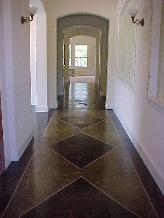Acid Staining
Acid Staining is a coloring process involving a chemical reaction between acid stain and concrete. Acid stain is a solution of water, acid, and inorganic salts that react with the minerals in the concrete giving a distinctive, permanent color with a subtly shaded marbled effect, similar to natural stone. The chemical reaction produces a permanent, rich, variegated color on the surface of the concrete. Because every concrete surface is different, staining provides a custom look that is ideal for residential, commercial, or municipal applications both interior and exterior.
Decorative concrete acid stains can transform ordinary concrete into a limitless palette of color and design. Even though acid stain is only available in eight basic colors (limited by the number of natural mineral salts), the colors can be diluted to achieve shades of each color, combined to create other colors, or layered giving a multi-hued variegated effect. It is designed for use on old and new concrete, residential, commercial, and municipal applications. Because acid stain reacts with the minerals in the concrete, acid stain is resistant to chipping, peeling, cracking, and fading, unlike conventional masonry paints and stains. Coupled with either a periodic application of a floor wax, solvent-based concrete sealer, water-based epoxy, or polyurethane sealer, the acid stain surface is easy to maintain and clean and will maintain its appearance and durability for years to come.
At Designer Concrete & Supply, Inc., we have selected two leading decorative concrete manufacturers of acid stain, Stain-Crete by Increte Systems and Kemiko Stone Tone Stain. Even though acid stain uses natural salts to color the concrete, each manufacturer has their own formula giving them slight variations in colors.
Scoring
To add an additional dimension to the design, the concrete surface can be scored. Scoring is a process of cutting or etching patterns into the surface of the concrete. Designs can include borders, tile patterns, large diamonds, curves, or custom-created design.
Key Benefits:
-
Design freedom
-
New life to old concrete surfaces
-
Variety of colors and patterns
-
Affordable alternative to tile
For more information, click on one of the links below: